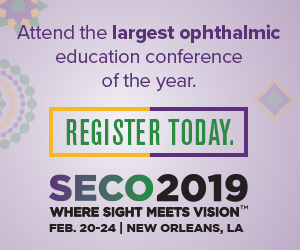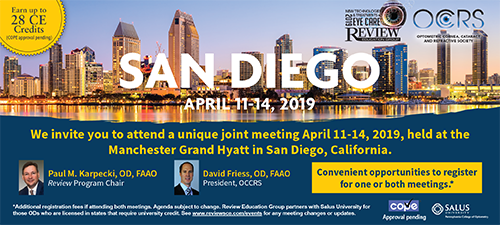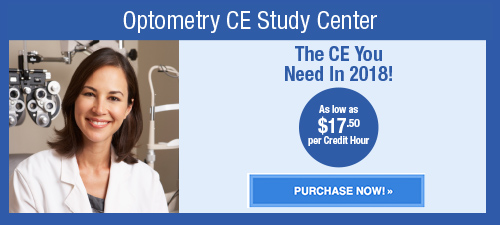
A
weekly e-journal by Art Epstein, OD, FAAO
Off the Cuff: Hey! This is Impor-unt
I’m not sure you’ve noticed it, but the spoken English language is becoming increasingly dysphonic. All you need to do is listen. At first, it was the rare mispronunciation of the word button. Button is a simple word, with a simple meaning, and it’s a word that’s simple to pronounce. But + tin = Button. Yet, with increasing frequency, I started to hear people pronouncing it with a strange-sounding, cockney inflection. Button was becoming buh-in, with the “t” nowhere to be found. It took me a while, but I think I finally figured it out. The missing "T"s and end-grunts are not British. It’s a Bronx accent.
|
|||||
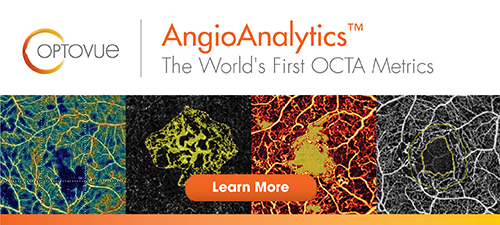 |
||
| Absorption and Extraction of Inflammatory Mediators From Contact Lens Materials | ||||
This report aimed to explore whether certain inflammatory mediators were absorbed, extracted or bound by various contact lens materials. Comfilcon A, balafilcon A, omafilcon A and etafilcon A were soaked in 500pg/mL and 100pg/mL of interleukin-8 (IL-8), matrix metalloproteinase-9 (MMP-9) or interleukin-1 receptor antagonist (IL-1Ra), and also in combined solutions of inflammatory mediators (500pg/mL or 100pg/mL) separately. Lenses were then extracted in 1:1 2% trifluoroacetic acid:acetonitrile. The extracted and residual concentrations of inflammatory mediators were determined using enzyme-linked immunosorbent assays. Absorbed (control-residual) and firmly bound (absorbed-extracted) concentrations were calculated for analysis.
More MMP-9 was absorbed by omafilcon A (466pg/mL ± 9pg/mL) than balafilcon A (437pg/mL ± 11pg/mL) or etafilcon A (428pg/mL ±13pg/mL) when soaked in 500pg/mL, with no differences in 100pg/mL. More MMP-9 remained firmly bound to omafilcon A (174pg/mL ± 3pg/mL), comfilcon A (168pg/mL ± 34pg/mL) and balafilcon A (186pg/mL ±14pg/mL) than etafilcon A (128pg/mL ± 22pg/mL). There were no differences in IL-8 absorption between lenses; however, more IL-8 remained firmly bound to omafilcon A (336pg/mL ± 25pg/mL) than etafilcon A (106pg/mL ± 133pg/mL) when soaked in 500pg/mL. No differences were found in concentrations of absorbed or firmly bound IL-1Ra between materials. When the mediators were combined, IL-8 was absorbed more in etafilcon A than in other lens materials, but the absorbed IL-8 did not remain firmly bound. Researchers determined that the uptake and extraction of inflammatory mediators from contact lenses was affected by competitive binding between the mediators. |
||||
SOURCE: Chao C, Richdale K, Willcox M. Absorption and extraction of inflammatory mediators from contact lens materials. Eye Contact Lens. 2019 Jan 29. [Epub ahead of print] |
||||
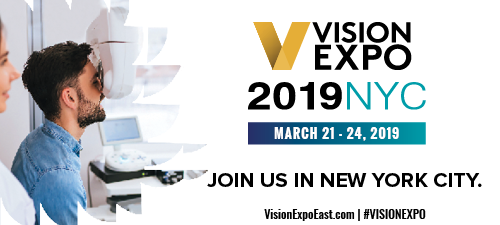 |
||
| Changes in Intraocular Pressure and Angle Status After Phacoemulsification in Primary Angle Closure Hypertension | ||||
A case-series of 18 eyes of 18 subjects was conducted to study the change in intraocular pressure (IOP) and angle status after phacoemulsification in a cohort of primary angle-closure hypertension (PACHT) patients. Preoperative biometry including axial length, anterior chamber depth (ACD), lens thickness and central corneal thickness were studied. Preoperative and postoperative IOP, number of topical glaucoma medications, angle swept-source optical coherence tomography (SS-OCT) parameters of nasal and temporal angle opening distance, trabecular iris space area, scleral spur angle, lens vault and circumferential iridotrabecular contact (ITC) were studied and their correlations derived.
The mean preoperative IOP, 31mm Hg ±6mm Hg, decreased to 14mm Hg ±1mm Hg at six months postoperative period, a fall by 58% ± 14%. The number of glaucoma medications reduced from four (three to five) to two (one to three). All SS-OCT studied parameters denoted significant angle widening postsurgery. The ITC percentage reduced from 52 (16 to 100) to 19 (0 to 97). The preoperative ITC showed moderate to strong correlation with all preoperative nasal and temporal angle parameters. It also showed moderate positive correlation with percentage fall in IOP at the one-month postoperative period. The preoperative ACD showed significant negative correlation with preoperative and postoperative ITC. Investigators wrote that PACHT patients benefited significantly from cataract surgery, with marked angle widening, IOP reduction and a decrease in the number of glaucoma medications. They added that SS-OCT-derived circumferential iridotrabecular contact indexes could be used as the single best parameter to indicate the preoperative angle status and predict postoperative change in IOP, as against the numerous single-section-measured angle parameters. |
||||
SOURCE: Selvan H, Angmo D, Tomar AS, et al. Changes in intraocular pressure and angle status after phacoemulsification in primary angle closure hypertension. J Glaucoma. 2019;28(2):105-110. |
||||
|
|||
| Rates of Ganglion Cell-Inner Plexiform Layer Thinning in Normal, Open-Angle Glaucoma and Pseudoexfoliation Glaucoma Eyes: A Trend-Based Analysis | ||||
The purpose of this study was to determine the rate of ganglion cell-inner plexiform layer (GCIPL) thinning by Cirrus high-definition optical coherence tomography (HD-OCT) in normal eyes and open-angle glaucoma (OAG) and pseudoexfoliation glaucoma (PXG) eyes. This was a longitudinal observational study. Researchers evaluated 282 subjects who visited a glaucoma clinic of a tertiary hospital in Korea: 60 healthy eyes, 193 medically treated OAG eyes and 29 medically treated PXG eyes with a minimum three-year follow-up involving serial spectral-domain OCT measurements of GCIPL thickness. The rates of thinning in the GCIPL thickness of the global region, six macular sectors and minimum thickness were determined by linear mixed models and compared within the normal, OAG and PXG groups. Additionally, the GCIPL thinning rates were compared between normal-baseline-IOP OAG (normal-tension glaucoma [NTG]) and high-baseline-IOP OAG (high-tension glaucoma [HTG]) eyes.
The mean rates of GCIPL thinning were -0.31μm/y in the normal eyes, -0.49μm/y in OAG and -1.46μm/y in PXG. The differences in the mean GCIPL thinning rates were statistically significant between OAG and PXG (normal vs. OAG; OAG vs. PXG; normal vs. PXG). Among the eyes with OAG, the treated NTG and HTG eyes showed no significant difference in GCIPL thinning rate (NTG vs. HTG=-0.41μm/y vs -0.66μm/y). Researchers determined GCIPL thinning rates for normal and undertreated OAG and PXG eyes, and found that differences existed among normal eyes and glaucoma types, with PXG progressing significantly faster than OAG. |
||||
SOURCE: Lee WJ, Baek SU, Kim YK, et al. Rates of ganglion cell-inner plexiform layer thinning in normal, open-angle glaucoma and pseudoexfoliation glaucoma eyes: a trend-based analysis. Invest Ophthalmol Vis Sci. 2019;60(2):599-604. |
||||
| News & Notes | |||||||||||||||
B+L Launches Sightmatters.Com to Help People With AMD
|
|||||||||||||||
| IDOC Announces Leadership Team Members, Record Attendance and IDOC Insider Launch IDOC announced four recent additions to the executive and management teams. Jill Johnson was named HR leader, Jan Cory became senior director, strategic partnerships, Bridgette O’Brien was named director of marketing and Scott Robinson joined as director of strategic partnerships. In addition, IDOC’s national conference, The Connection in Orlando (Jan. 30-February 2) was the largest in the group’s 20-year history. Finally, IDOC announced a new plan enhancement for members. Offered to members at no additional cost, IDOC Insider combines state-of-the-art data and sell-through analytics technology with customized, metrics-driven business recommendations and incentives based on individual practice data. Read more. |
|||||||||||||||
|
|||||||||||||||
|
|||||||||||||||
|
Optometric Physician™ (OP) newsletter is owned and published by Dr. Arthur Epstein. It is distributed by the Review Group, a Division of Jobson Medical Information LLC (JMI), 11 Campus Boulevard, Newtown Square, PA 19073. HOW TO ADVERTISE |


